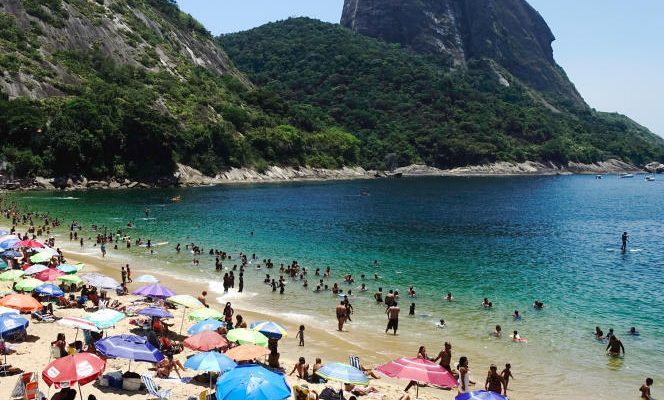LETTER FROM RIO DE JANEIRO
Autumn has started in the tropics: the most beautiful season to visit Rio de Janeiro. The Praia Vermelha (Red Beach) shines in the morning sun. Nestled between the hills of tropical forest, this heavenly cove in the heart of the city and at the foot of the imposing Sugar Loaf Mountain would be enough on its own to award the city its nickname of “Marvelous City”. Except that… an ugly green and fuchsia stain spoils the panorama. In fact, a tarp that covers the work in progress at the top of Pão de Açúcar on a project that divides the Cariocas: a zip line.
755 meters long, it must link Sugar Loaf (396 meters) to its little neighbour, Morro da Urca (220 meters) by the end of the year. Enough to offer thrills to tourists, who will be able to soar into the void at 100 kilometers per hour, on four separate cables, while contemplating one of the most beautiful urban landscapes in the world. The project, led by the private company Parque Bondinho Pão de Açúcar, responsible for administering the natural monument, aims to make places nothing less than “the best integrated platform for sustainable experiences in tourism, entertainment and media in South America”.
But a large part of the inhabitants of Rio, and in the first place of the neighborhood of Urca, do not approve of this attraction. The sociologist Rodrigo Veloso, 29 years old and long hair, within the Movement Pain de Sucre without zip line, is one of the leaders of the sling. “Parque Bondinho did not consult anyone for this project and committed several illegal acts. They razed 70 square meters of forest and pierced the rock, which is totally prohibited in this classified place. » The zip line, he said, “will produce unbearable noise pollution for local residents and generate an influx of tourists that will completely congest the Urca district”.
The postcard from Rio
The fight is highly symbolic, because the Sugar Loaf has always been the postcard of Rio and Brazil. The origin of its name remains mysterious, but no one would dare to dispute its status as a lookout on the destiny of the city since its foundation in 1565. Its granite slopes, which welcome hikers and climbers, are also home to a number of monkeys, birds and tropical plants. Classified heritage in Brazil as in Unesco, the places have been accessible since 1913 thanks to a cable car, affectionately nicknamed the “bondinho” (“small tram”), which serves in two successive journeys the Morro da Urca then the Sugar Loaf from Praia Vermelha. More than 1 million tourists use it every year.
You have 49.62% of this article left to read. The following is for subscribers only.
